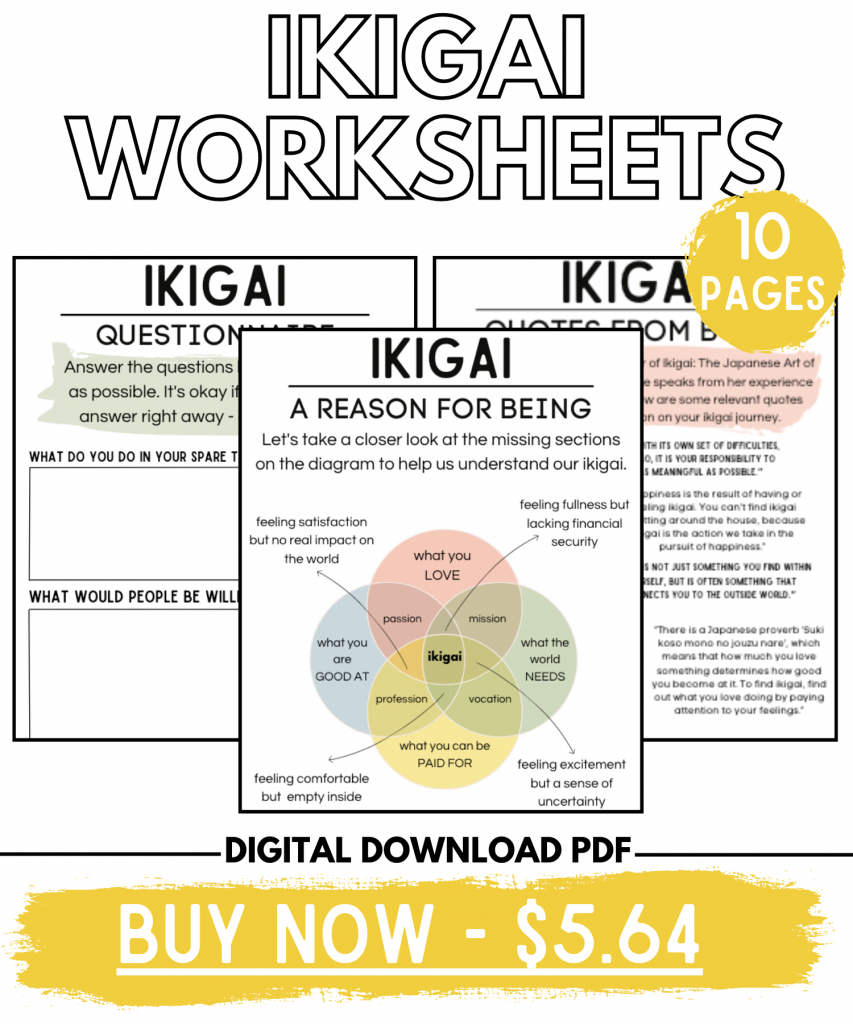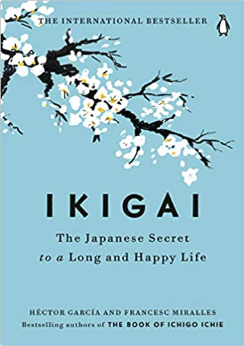Ikigai is a simple Japanese concept that will empower you to find your purpose. When you find your ikigai, you’ll notice the overall shift that occurs in your life. Loosely translated, the meaning of ikigai, an old Japanese ideology, is “a reason for being.” I intend to keep this post simple and easy to understand, so that you can effectively apply this knowledge to your life, as smoothly as possible.
DISCLOSURE: For the sake of transparency, some of the links in our content are affiliate links. This means I get a commission if you purchase through my links, at no cost to you. Read the full disclosure here.
What is Ikigai?
Ikigai is a combination of the words “iki” (to life) and “gai” (reason), which is used to describe finding joy through purpose. There is no exact translation, but there are many rough translations of ikigai, such as a life worth living or something to live for. From my understanding, ikigai signals a sense of finding and living your purpose. Purpose gives you something to live for, and if correctly applied, you will benefit from the happiness that comes with your reason for being.
Find Your Ikigai: A Japanese Concept That Will Empower Your Life
The 4 Components of Ikigai
The four intersecting circles below are widely used to explain the four components of finding purpose and embracing your life. Let’s break down each of the components.

1. What do you love?
Finding what you love trickles down to a combination of your passion and mission in life. Make a list of the things that you love and what you perceive to be your mission in this world. Find a way to combine the two.
2. What are you good at?
A profession combined with passion will give you a sense of what you’re good at. You aren’t required to be passionate about one singular thing. For example, I’ve finished three diplomas, and I work with numbers. However, my passion lies in travel, education, and blogging. I’m aware of what my ikigai looks like, and I actively pursue this daily.
3. What does the world need?
The world needs your mission and vocation. Vocation refers to something that you are drawn to or trained to do. Your voice and perspective are unique. You bring something to this world that nobody else does.
4. What can you be paid for?
Now, take your vocation and profession – give them a nice little whirl, and there you have something you can find ways to monetize.
These four components are meant to guide you in your self-discovery. I’m sure you’ve heard the saying ‘if you do what you love – then you’ll never have to work a day in your life’. Finding your purpose and being paid to wake up to it every day is a special kind of feeling.
How do you find your Ikigai?
Often Ikigai is described as “the reason you want to get out of bed in the morning.” Yet, it’s not enough to want to get out of bed in the morning – we need to understand the why. Finding your ikigai comes from digging down to the root of why.
I’ve created a free easy-to-use ikigai pdf worksheet, to encourage your self-discovery and ultimately help you find your ikigai. The ikigai test is a basic questionnaire to help you get started on gathering relevant information about your unlimited potential.
Honestly, there have been plenty of times in life when I’ve felt discouraged and thought of calling it quits, but I didn’t. I still blog because it’s going to bring me the millions (kidding, kinda). I blog because I get to help others and that’s where it’s at for me (ok, fine – I’m not all that selfless – secretly, I hope to be my own boss one day, traveling the world and leaving a trail of cookie crumbs along the way). Therein lies my Ikigai.
Ikigai examples range from person to person. We all don’t have the same ideas of passion, mission, vocation, or profession. As I mentioned above, my Ikigai, for the most part, is being in service to others and myself. I enjoy blogging because it allows me to help others and provides me with a sense of direction in living my dreams.
To find my ikigai, I started small by making changes to my way of life. For example, I began by working on truly appreciating the small things in my life and finding joy in those moments. Moments that consistently bring me joy include (but are not limited to); playing fetch with my dog – Dobby, having a smooth cup of Ceylon tea – while being warmed by the sun, and sipping on a cold iced coffee in the summer – just hits the spot.
Finding my ikigai meant accepting that I could have more than one ikigai and that there is a possibility for change as I move through life. I’m going to outline five steps below, which I learned from an ikigai author – which really put finding my reason for being into perspective.
5 Steps To Finding Your Ikigai
Ken Mogi, a Japanese scientist, researcher, and author – wrote “The Little Book of Ikigai“, in which he highlights five pillars, that can be used as your guiding steps to finding your ikigai.
Step 1: Starting Small
You can achieve your goals by taking small, yet meaningful steps. There is no need or point to rush through anything. Taking small steps will garner great results in the long haul.
Step 2: Releasing Yourself
If you’ve heard the phrase ‘comparison is the thief of joy’ – then you must know how much truth it conveys. We need to find happiness through acceptance. Acceptance of the way things are and our way of life is a major key to releasing yourself.
Step 3: Harmony and Sustainability
If we think beyond ourselves then we can often avoid conflict and maintain peace. Be mindful of your actions and the impact they can cause on the environment and others.
Step 4: The Joy of Little Things
As I mentioned above – finding joy in the little things is so incredibly important. Appreciate and make room for gratitude to start noticing small moments of joy, that come in many forms.
Step 5: Being in the Here and Now
Lastly, be present. Try not to dwell in the past or think about the future. Find contentment with the simpleness of everyday life. This might look like bringing out your inner child to find the beauty in the things, that we may otherwise overlook, as we hustle through life.
Frequently Asked Questions
How is ikigai pronounced?
The correct pronunciation of Ikigai is ”ee-kee-guy” not ”eye-ka-guy.
Why is ikigai misunderstood?
Ikigai is misunderstood to some degree because of the Venn diagram created by Marc Winn in 2014. The diagram was actually from Andres Zuzunaga as a means to understand your purpose. Marc changed the word purpose to ikigai to merge the two concepts together.
Who invented the word ikigai?
The word ikigai comes from the Heian period (794 to 1185 CE). Psychologist Akihiro Hasegawa explained in a research paper that the word “gai” translates to shell in Japanese. During the Heian period, shells were quite valuable, hence understanding “value in life.”
Is ikigai possible?
Yes, it most certainly is possible to find your reason for being. I find ikigai in blogging, taking care of the people I love, helping others, and spending time with loved ones. Your purpose does not have to be a complicated way of life or a difficult-to-reach destination.
How to find ikigai?
You can find ikigai through a hobby, a person, or your work. Finding your ikigai does require some deep thinking, which might involve a brainstorming session, an ikigai test, reading this blog post, completing a questionnaire, and using an ikigai workbook. The answers we need are within us and it’s a matter of finding tools to draw them out.
Can a person be your ikigai?
Yes, a person can be your ikigai. If the reason you get up out of bed is a person – then that’s totally fine. Your ikigai can be anything that feels like an intersection of your passion, mission, profession, and vocation.
Does everyone have an ikigai?
Yes – however sometimes you might not find it and that is okay. You could have more than one ikigai and it may even change within your lifetime – all of which are okay.
Further Learning: Books
Ikigai: The Japanese Secret to a Long and Happy Life
I was inspired to write this blog post because of the book I linked right here, for your learning pleasure. I highly encourage you to read this book, because it houses so much juicy content, about finding and living a happy life.
The Ikigai Journey: A Practical Guide to Finding Happiness and Purpose the Japanese Way
Pair this guidebook with the book above to help you discover your ikgiai. This guidebook provides practical exercises to help you delve deep.
Ikigai: The Japanese Art of a Meaningful Life
This particular book on ikigai is written by a Japanese native – who better to learn from than someone that has experienced it themselves? Yukari shares case studies from a range of people on their ikigai.

I hope you find your ikigai and welcome a fulfilling life on your journey. The Japanese concept of ikigai is only as simple as you allow it to be. The reason I stress simply is to remind you not to overcomplicate life. Find joy through purpose by connecting all the things you want in life and accepting that you can have more than one purpose. Don’t forget that joy isn’t found only in the destination – embrace the journey (and never say no to chocolate chip cookies).
***
Did you find your ikigai, or are you searching for it? Let me know in the comments below.








